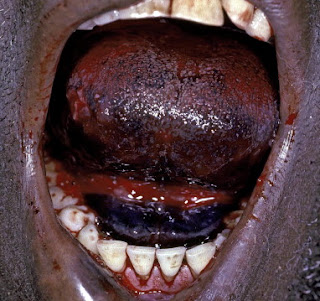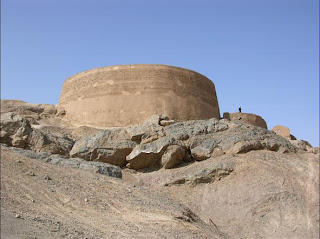A “Tower of Silence” or Dahkma is the place where Zoroastrians laid their dead to rest in the life-giving power of the sun. Zoroastrian tradition considers a dead body—to be nasu, unclean. Specifically, a corpse demon was believed to rush into the body and contaminate everything it came into contact with, hence the Venidad(an ecclesiastical code "given against the demons") has rules for disposing of the dead in a safe manner. Zoroastrians expose their corpses to the sun as they believe it has the ability to destroy pollutants and disintegrate flesh. The exposure procedure is called ‘Khurshed nigerishn’ which in Pahlavi means ‘beholding by the sun’. To preclude the pollution of earth or fire, the bodies of the dead are placed atop a tower—a tower
of silence—and exposed to the sun and to birds of prey. In ancient times bodies were fastened to the ground so that they could
not be dragged toward any life form, vegetation, water body or human
settlements and defile them.
The towers, which are fairly uniform in their construction, have an
almost flat roof, with the perimeter being slightly higher than the
center. The roof is divided into three concentric rings: The bodies of
men are arranged around the outer ring, women in the second circle, and
children in the innermost ring. Once the bones have been bleached by the
sun and wind, which can take as long as a year, they are collected in
an ossuary pit at the center of the tower, where—assisted by lime—they gradually
disintegrate and the remaining material—with run-off rainwater—runs
through multiple coal and sand filters before being eventually washed
out to sea.
Zoroastrians have stopped this ancient practice. Today, they bury their dead and use a layer of concrete to secure
the ground from contamination. “Towers of Silence” still stand in many parts of Iran, especially in
the provinces of Yazd, Kerman and Tehran.
 |
| An aerial view of an ancient tower on the outskirts of Yazd, Iran - LINK |
 |
| Dkhma near the city of Yazd - LINK |
 |
| Tower of silence in a remote area near the city of Yazd, Iran - LINK |
 |
| Zoroastrian tower of silence near Yzad, Iran. Photo credit: Robert Harding |



























































